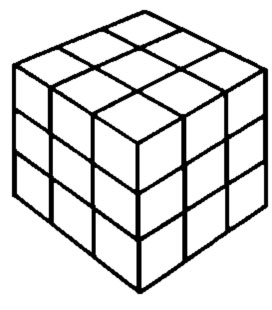STEM: Think of a Cube, Three Elements to a Side
From Richard C. Larson
 STEM, STEM, STEM, everyone is talking about STEM. But look at STEM more closely and we find all sorts of diversity. Consider diversity of production of STEM graduates: We find that PhDs in life sciences are being overproduced, so in that domain there is no STEM crisis. Or, if there is a crisis, it is one of overproduction and underemployment. In computer science and other IT fields, it seems there is still a growing need for more STEM graduates. So “STEM” does not fully describe Science, Technology, Engineering and Math any more than “Humanities” describes literature, history, art and anthropology. We need to split the word apart and understand its constituent pieces. STEM, STEM, STEM, everyone is talking about STEM. But look at STEM more closely and we find all sorts of diversity. Consider diversity of production of STEM graduates: We find that PhDs in life sciences are being overproduced, so in that domain there is no STEM crisis. Or, if there is a crisis, it is one of overproduction and underemployment. In computer science and other IT fields, it seems there is still a growing need for more STEM graduates. So “STEM” does not fully describe Science, Technology, Engineering and Math any more than “Humanities” describes literature, history, art and anthropology. We need to split the word apart and understand its constituent pieces.
Apologies for being simple, but as an educator let me suggest three dimensions of STEM, each with its own three elements:
 1. Knowledge of STEM 1. Knowledge of STEM
a. Direct basic content;
b. Hands-on design and creation;
c. Deep and fundamental.
2. Pedagogy of STEM
a. Passive listening lecture;
b. Student-specific computer-based learning;
c. Collaborative active learning.
3. Career relevance of STEM
a. Engineer/scientist;
b. Technician;
c. Liberal arts major.
Let’s take these nine elements, one at a time.
1. Knowledge of STEM.
a. Direct basic content. In math and science there are certain things one needs to know, like your numbers between 1 and 100, basic arithmetic operations such as addition and subtraction; the existence of the periodic table in chemistry, etc. This is the stuff that must be learned, perhaps even memorized at some time, and eventually become ‘second nature’, engrained in the student. Problem: Too many people—including some teachers and educators—think only of this type of STEM content knowledge, leading to didactic lecturing, teaching to a test and rewarding rote memorization. Faced with a STEM problem not seen before, the student is likely to be paralyzed. Basic content STEM knowledge is a necessary but not sufficient condition for competence in our STEM-focused students.
b. Hands-on design and creation. This type of knowledge requires the student to apply general principals of STEM towards the design and building of things, things like robots, miniature cars and rockets. Developing this type of knowledge requires advancing well beyond multiple-choice test competency, allows the student to go down dead ends and eventually builds confidence and excitement. Problem: Some innovators in education think that robot competitions are one of the best STEM educational activities. Exciting, yes, Educational, yes. But automatically bringing comprehensive knowledge of STEM? No. Additional problem: Robot competitions and the like can create a negative stereotype that turns off many, especially females, who otherwise might be attracted to STEM study and careers.
c. Deep and fundamental. This is the hard stuff, roll up your sleeves and put on your thinking cap. My favorite setting for this: Give the student a problem that she has not seen before, one that requires deep understanding of some subset of STEM knowledge and concepts, and have the student approach the problem only with a blank sheet of paper and a sharpened pencil. Allow time to go down dead ends. This is what scientists and many engineers do every day. It’s what we should be encouraging many STEM students to do as well. Problem: Creating and grading such problems is difficult; many teachers do not have the in-depth knowledge required to “Go Deep.”
2. Pedagogy of STEM.
a. Passive listening lecture. This remains the dominant mode of teaching STEM subjects. And not all lecturing is ineffective and boring. Witness the tremendous popularity of MIT Professor Walter Lewin’s 100+ video lectures in physics, all freely available on the Internet. I have copies of hundreds of unsolicited emails he has received from students and non-students from around the world, telling him how his lectures have changed their lives for the better. He is a physics-teaching rock star! Problem: Few teachers have Lewin’s gifts for teaching or his willingness to prepare 40 hours for each hour of lecturing. In student surveys, passive learning lectures are often placed last in perceived educational effectiveness, in comparison to up to a dozen other ways students learn in college. Opportunity: Like Lewin’s physics lectures, there are thousands of excellent lectures now freely available on the Internet under OER licensing. The majority of current face-to-face lecturers could direct their students to these online world-class lectures, and then devote their teaching time to more focused activities, such as mentoring students on an individualized basis. This could increase the effectiveness of STEM teaching without added costs.
b. Student-specific computer-based learning. The rising trend is for students to sit in front of computers and to learn at the keyboard and screen. At the beginning, most of this was simply text on a screen, and then followed by video lectures on a screen. But now we have animations, complex educational games, on-line personalized software tutors and more. Potentially we have a very rich environment for STEM learning. Problem: Experience has shown us that students’ staying power in a one-on-one education-focused relationship with a computer is low. The dropout rates for MOOC’s is typically 95%, and many attribute this to lack of a human cohort of like-minded learners, working together as a group trying to learn the material. Opportunity: So, it appears that effective STEM learning at the computer will require some advances in social science knowledge to reintroduce learning cohorts into the learning environment. STEM learning in particular requires lots of give-and-take discussion among students. Student surveys often report that the most effective way for them to spend an hour learning STEM is with a small cohort of like-minded students, as they all learn from each other.
c. Collaborative active learning. This type of learning, usually with small student teams of three or more, can be applied to virtually any STEM learning challenge: working on complex homework problems, designing and building things, applying science and engineering to solve some important social problem. Students often report immense satisfaction with this type of learning, many citing life-memorable experiences. Such collaboration comes closest to what professional scientists and engineers do -– every day. Problem: We need to train STEM teachers on how to identify, mentor and evaluate such projects. Accustomed to giving scripted lectures, many STEM teachers are uncomfortable with learning environments and student assignments that are open-ended, unscripted, and often will take the class or team in directions unknown to the teacher. Opportunity: In such an open-ended environment, teachers will learn yet again that, “Teaching is a Learning Experience.” It’s OK to say, “I don’t know. Let’s examine this together.”
3. Career relevance of STEM.
a. Engineer/scientist. Most people who think of the need for STEM education envisage the creation of the next generation of scientists and engineers. And, yes, this is important. And excellent scientists and engineers will probably experience STEM education with a combination of the ingredients discussed above, hopefully with good doses of deep and fundamental knowledge and collaborative active learning. Problem: Scientists and engineers comprise about 5 percent of the U.S. working population. It is inconceivable that we would accept 95% STEM illiteracy in the U.S. Opportunity: We need also to seek the relevance of STEM to the rest of the population.
b. Technician. Think of auto mechanics, electricians, plumbers, HVAC (heating, ventilation, and air conditioning) professionals, utilities repairmen, and more. Each of these job types is now a STEM job. The average new car has 50 to 200 microprocessors. Gone are the days when a teenager can roll under the family jalopy and easily fix things. Those who successfully pursue technical careers now must know the basics of science, engineering and technology applicable to their profession. Problem: Without effective STEM education, appropriately focused on their career path, it is unlikely that they will succeed. Opportunity: Perhaps they do not need to Go Deep as in 1c above, nor do they need to know the general theory at the depth of a scientist-to-be or engineer-to-be, but they are likely to acquire over time specialized trade knowledge that is even deeper than that of engineers and scientists.
c. Liberal arts major. Last but certainly not least, let’s take the majority of the population who will not be in STEM-related careers, not scientists or engineers or technicians. For lack of a better description, we call them liberal arts majors, realizing that there is no one fixed set of words that describes “everyone else.” Our contention is that core STEM knowledge in the 21st Century is, for a populace, just as important as reading literacy. Members of a population vote. They elect people to political offices, from which limited public resources are allocated. Much of this resource allocation relates to STEM, from environmental sustainability, to subsidizing promising emerging technologies, to deploying national defense systems, to facilitating driverless cars, to allowing (or not allowing) Google Glass, etc., etc. Only a STEM-literate populace can intelligently make these types of decisions.
STEM, as we have described is multi-dimensional. With our educator cap on, we have structured a discussion of STEM along the geometry of a three-dimensional cube, with three separate elements on each side, not unlike a Rubik’s® Cube! One could easily get more complicated, with more dimensions and more elements on each side. But we have tried to argue that STEM is not a single explanatory word that can be used in declarative sentences like, “We have a national STEM crisis!” Or, that “STEM is only for engineers.” STEM has many dimensions, and our dialogue must reflect that complexity. There are numerous options now with STEM teaching and learning, and we need to carefully select that best match to student and teacher. Above all, we need to realize that STEM is now for everyone; else others who may not reflect our own priorities will make important policy decisions. STEM literacy is just as important as reading literacy.
Richard Larson is the Mitsui Professor of Engineering Systems at MIT. He is also the Director of MIT LINC and the Principal Investigator of MIT BLOSSOMS.
Back to newsletter |